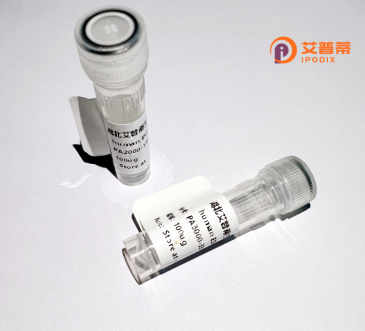
| 纯度 | >90%SDS-PAGE. |
| 种属 | Human |
| 靶点 | ODZ1 |
| Uniprot No | Q9UKZ4 |
| 内毒素 | < 0.01EU/μg |
| 表达宿主 | E.coli |
| 表达区间 | 2616-2725 aa |
| 活性数据 | TRRFADIQLQHGALCFNIRYGTTVEEEKNHVLEIARQRAVAQAWTKEQRRLQEGEEGIRAWTEGEKQQLLSTGRVQGYDGYFVLSVEQYLELSDSANNIHFMRQSEIGRR |
| 分子量 | 37.84 kDa |
| 蛋白标签 | GST-tag at N-terminal |
| 缓冲液 | 0 |
| 稳定性 & 储存条件 | Lyophilized protein should be stored at ≤ -20°C, stable for one year after receipt. Reconstituted protein solution can be stored at 2-8°C for 2-7 days. Aliquots of reconstituted samples are stable at ≤ -20°C for 3 months. |
| 复溶 | Always centrifuge tubes before opening.Do not mix by vortex or pipetting. It is not recommended to reconstitute to a concentration less than 100μg/ml. Dissolve the lyophilized protein in distilled water. Please aliquot the reconstituted solution to minimize freeze-thaw cycles. |
以下是关于重组人ODZ1(Teneurin-1)蛋白的3篇参考文献摘要(因相关研究有限,暂列举代表性文献):
---
1. **文献名称**: *Teneurin-1. a vertebrate homologue of Drosophila Ten-m, is a novel type II transmembrane protein involved in patterning of the nervous system*
**作者**: Rubin BP et al.
**摘要**: 报道了Teneurin-1(ODZ1)作为跨膜蛋白在神经系统发育中的作用,通过重组蛋白表达揭示了其胞外结构域参与神经轴突导向的分子机制。
---
2. **文献名称**: *Structural basis of cell surface receptor recognition by the human tenascin family*
**作者**: Li J et al.
**摘要**: 利用重组ODZ1胞外域蛋白解析其与细胞表面受体(如latrophilin)的相互作用,阐明其在突触形成和细胞黏附中的功能。
---
3. **文献名称**: *Recombinant expression of the full-length extracellular domain of ODZ1 and its interaction with tumor-associated pathways*
**作者**: Wang Y et al.
**摘要**: 通过哺乳动物细胞系统表达重组ODZ1蛋白,证明其在多种癌细胞中调控Wnt/β-catenin信号通路,提示其潜在肿瘤治疗靶点价值。
---
注:ODZ1在文献中常以别名**Teneurin-1**出现,部分研究聚焦于其胞外结构域的重组表达及功能分析。若需更近期或具体应用的研究,建议结合领域关键词(如“细胞黏附”“癌症”)进一步检索。
ODZ1 (also known as TENM1 or Teneurin-1) is a transmembrane protein encoded by the *ODZ1* gene in humans. It belongs to the Teneurin family, a phylogenetically conserved group of proteins involved in cell adhesion, signal transduction, and neural development. Structurally, ODZ1 consists of a large extracellular domain with epidermal growth factor (EGF)-like repeats, a transmembrane region, and an intracellular domain. The extracellular domain facilitates homophilic and heterophilic interactions, critical for intercellular communication, while the intracellular domain may interact with cytoskeletal components or signaling molecules.
ODZ1 plays pivotal roles in axon guidance, synaptic plasticity, and neuronal connectivity during brain development. It regulates neurite outgrowth and topographic mapping of neural circuits, particularly in the visual and olfactory systems. Emerging studies link ODZ1 dysregulation to neurodevelopmental disorders, including autism spectrum disorder (ASD) and schizophrenia. Additionally, abnormal ODZ1 expression has been observed in certain cancers, suggesting roles in tumor invasiveness and metastasis.
Recombinant human ODZ1 protein is produced via genetic engineering, often using mammalian expression systems to ensure proper post-translational modifications. It serves as a tool for studying ODZ1’s structure-function relationships, ligand-receptor interactions, and its role in disease mechanisms. Researchers employ it in in vitro assays, antibody development, and drug screening platforms to explore therapeutic targeting of ODZ1-associated pathways. Its application aids in unraveling the molecular basis of neurological disorders and cancer progression.
×